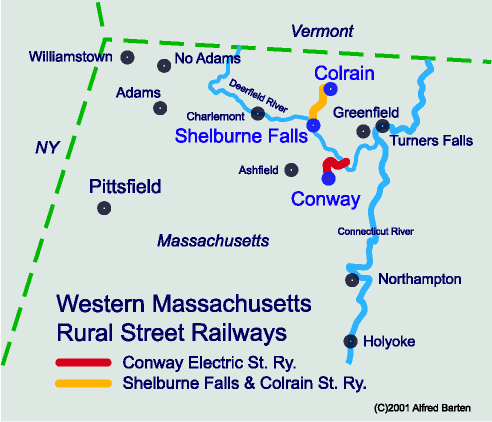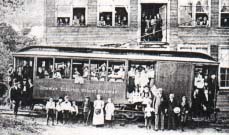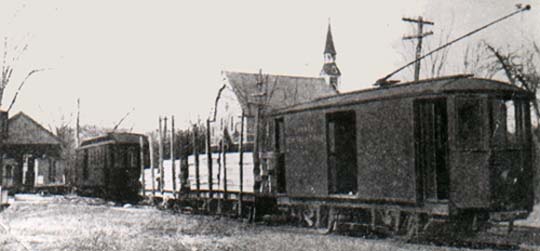|
CESR | THE
Conway Electric Street Railway was the very embodiment of a rural street
railway, remote and uniquely fashioned to the town it served. The
6-mile road, nestled in the hills of Western Massachusetts, operated
from November 3, 1895 to sometime in 1921, providing Conway's citizens
and businesses with a vital link to the Boston & Maine and New Haven
railroads, and thus the outside world. At the end, the little red cars
just stopped running. No one knows exactly when. Just that it was
sometime in the early spring of 1921.
The quiet town of Conway was once a thriving industrial center that included grist and saw mills, tanneries, and textile and cutlery manufacturing. In the years before the Civil War, Conway boasted its largest population ever - over 2000. Its business leaders fully expected Conway's population to someday reach 10,000. But massive railroad building in the 19th century did much to alter the economic and social fortunes of rural communities. Those connected to the rail lines thrived; those not connected lost out. WHEN TROLLEYS were shown in the early 1890s to be a less expensive, easily constructed alternative to steam railroads, Conway's merchants and citizens were quick to lay plans and dig deep into their pockets for a trolley line. In 1895 the Conway Electric Street Railway became the first street railway in Massachusetts to be chartered to carry freight. The line also carried passengers. Regularly scheduled daily trips were timed to provide easy connections with the New Haven and B&M; trains. The company developed, by way of its affiliated Conway Electric Light & Power Company, a recreational trolley park. Wildwood Park, as it was known, was alongside the power dam reservoir. The two attractions provided much pleasure for Conway's citizens and visitors from the region and, of course, encouraged riding the trolleys. SO SUCCESSFUL at first was the little line that railroad companies began to see trolleys as complementary rather than competing entities, with trolleys serving as connectors from remote or difficult-to-reach areas to the railroads. The Boston & Maine, by special act of the State Legislature in 1907, was permitted to acquire majority control of the Conway Electric, which it did in 1908. The relationship benefited both companies at first, but the trolley line's mounting deficits in later years soured the deal, and the Boston & Maine decided to abandon the trolley line. ONCE AGAIN Conway residents made an heroic effort. This time to save their little line. In 1919 a group of five Conway residents bought out the B&M;'s share and attempted to run the line themselves. Sometime in early spring of 1921, after a powerhouse failure and heavy snowstorm delivered a one-two punch that halted all traffic, the Conway Electric gave up the ghost.
Alfred Barten, 23 February 2001.
|

 ALL BUT FORGOTTEN is
the heroic role the little line played in slowing, if not ultimately
stemming the town's declining business fortunes of the late 19th
century. Four times, from 1849 through 1891, Conway had expected to have
a railroad come to town and four times the plans fell through,
primarily because of the steep grades a railroad would encounter in
reaching Conway's center.
ALL BUT FORGOTTEN is
the heroic role the little line played in slowing, if not ultimately
stemming the town's declining business fortunes of the late 19th
century. Four times, from 1849 through 1891, Conway had expected to have
a railroad come to town and four times the plans fell through,
primarily because of the steep grades a railroad would encounter in
reaching Conway's center.
